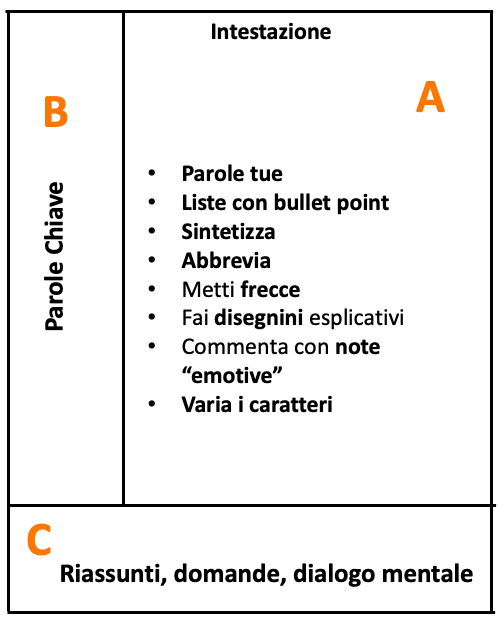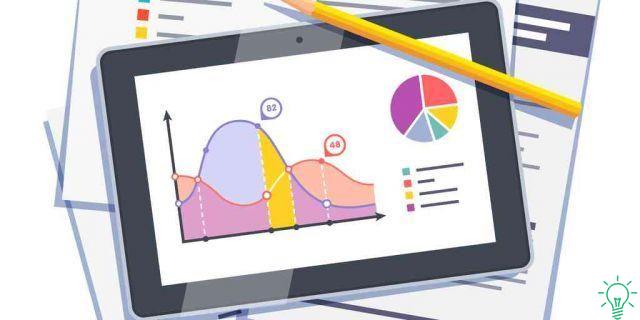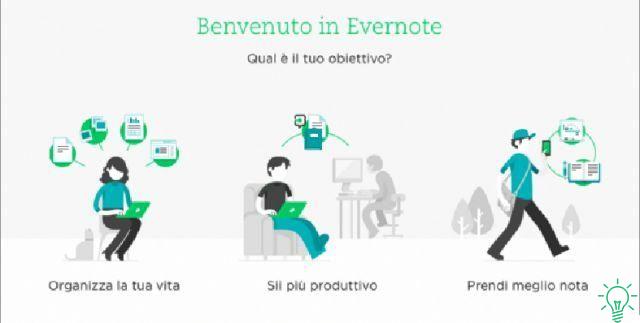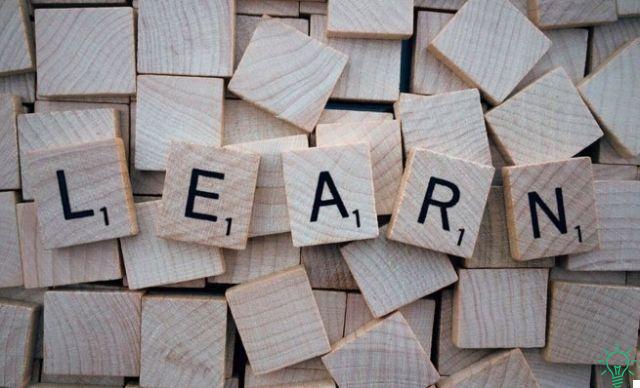
Conceived almost 80 years ago by prof. Walter Pauk of Cornell University in New York, the Cornell method it is the most effective system I know of for taking notes.
Despite its simplicity - at the end it is a sheet divided into 3 parts - the Cornell method allows you to follow a lesson, a conference, a business meeting:
- Keeping your concentration at the highest level
- By increasing understanding and involvement with respect to what you hear
- In the end, you find yourself with a clear and tidy material, ready (or almost) to be memorized
But let's see first of all what it is that doesn't work the way you normally take notes.
Traditional method vs Cornell method
Most people, when they learn to take notes, simply try to record the information they receive on a sheet of paper.
That is, they listen passively, and just as passively they transfer to the notebook what they hear.
In doing so, their brains are, I don't say shut down, but definitely working with reduced traction.
And so the concentration is lowered, boredom takes over and obviously the total quality of the brain work collapses.
The flow of information remains to a state of superficial analysis and manipulation: the one in which we limit ourselves to transforming sounds into words of complete meaning and to put them on paper.
And if, as many do, while you listen you are concerned above all with transcribing everything, you do nothing but add inefficiency to inefficiency.
Indeed:
- You don't have time to think, and therefore any intellectual involvement with respect to what you feel disappears
- Since it is difficult to write everything down, your level of attention and understanding drops further. You are in fact too busy not to miss a single word!
You have, in short, the illusion of listening; but actually you're working more or less like a tape recorder, you're just not as fast.
Il Cornell method instead, prescribing precise rules to fill in the notes, challenges you to intervene, immediately, on the information you receive.
In particular, you must:
- Select, according to priority, the information you are given
- Conceptualize them
- Compress them so that they are shorter
- Organize them
- Prepare them for an effective review
But how does it work in practice?
The three sections of the sheet in the Cornell Method

Take a nice large sheet of paper (I usually use A3 notebooks) and divide it into three sections.
1. Right section of Cornell notes (area A)
It is the one in which the actual notes are taken.
At the top, head the sheet with what we could define the master data of the lesson (date, theme, speaker, etc).
Under them, write the actual notes, using the same principles we saw when talking about waterfall schemes:
- Uses your words, helps you conceptualize
- Write liste con bullet point, it helps you to give order and hierarchy to the info
- Summarize like you were on twitter, helps you grasp the essence
- Abbrevia the words as if you were writing a text message, because it forces you to think about the word you write
- Metti arrows, to highlight the logical relationships
- Make doodles explanatory, they stimulate the "visual" and creative part of your cortex
- Comment every so often what you write with note “emotive” (“That's disgusting!” “Interesting!” “Nice!”), Will help you memorize better
- Vary the fontsi using italics, block letters, uppercase, lowercase, underline etc.
2. Left Section of Cornell Notes (Area B)
It is the section dedicated to keyword, which must be:
- Poached: as little as possible, also because the space available is deliberately reduced
- synthetic: that is, not sentences, but single nouns / adjectives
- Evocative: they must remember the content of the right section both conceptually and mnemonic
It is precisely these types of limits, not easy to respect, that make the Cornell Method effective.
To choose the right words you will have to squeeze your brains out and stay focused very high.
It doesn't matter (in fact, it's normal) if you can't complete this section during the lesson, you can do it later.
You can also transform the keywords into images and insert them in a palace of memory.
3. Lower section of the Cornell notes (Area C)
Here you put a micro-summary of the page content.
Additionally, you can jot down questions, make brief considerations, write down reminders, impressions, connections, or anything your brain dialogue deems useful.
For example. The above reminds me that…. Why does X happen ... Go and review the text Z ... etc.
This part can also be started during the lesson, but is mostly done afterwards.
Pbecause the Cornell method is effective
The effectiveness of the Cornell method is based on two main facts:
- During class, forces you to listen actively, and makes it even more performing since you have to transfer listening to paper, thus closing the cerebral loop listening-re-elaboration-action. The info you have to acquire in this way completes a complete cycle and becomes much more stable also from a mnemonic point of view.
- After the lesson, it forces you to work the material in a manner analytical and synthetic, and then allows you the three-level review of different details: that of the summaries (lower section), that of the keywords (left section), that of the total of notes (right section), with each level that can be reviewed separately or together with the others.
Not only so you learn more as you take notes, but you also have a tool of more structured and faster study / review.
Conclusions on the Cornell Method
Many people, when they take notes or write diagrams, underline, make maps, read a book, make a fundamental mistake: they put everything on the same level.
That is, they concentrate on the quantity of information, trying not to miss any of it.
Unfortunately, however, the anxiety of not missing anything and not leaving behind some fundamental information, in the end makes them work in mechanical way, not to mention stupid.
The paradoxical result is that after a few minutes they already remember almost nothing of what they write, read or underline and their notes or diagrams take on the appearance of impenetrable walls of words.
What you have to do, however, is dedicate yourself to the qualitative aspects, starting right away to evaluate, analyze and above all choose the one that is worth focusing on.
In this way, thanks to the mental effort that these operations require, you will begin to learn immediately.
This is a principle that we have seen many times on the blog.
When you try to manipulate the study material according to some precise rules, you manage to increase:
- the speed with which it processes the material, as is the case with fast reading and skimming
- memorization, think for example of active recall or memory techniques
- understanding, as when you rewrite the study material with the Feynman technique
In reverse, when you behave passively, hoping that by dint of repetition the material is transferred, as by osmsosis, in your brain, the results take a long time to come.
Remember then, even when you use the Cornell method, that if you leave information behind it is not a big problem: between the internet, transcriptions, books, other people's notes, if it is really important you will always find a time and a way to recover it.
Once you've invested time in taking notes that you won't remember anything about, well, that time is lost forever.
Hurray therefore the Cornell method and all the other methods that, in different ways, place limits on our natural tendency to do too much, and to do it at the expense of what is essential. A greeting. Anthony.


























